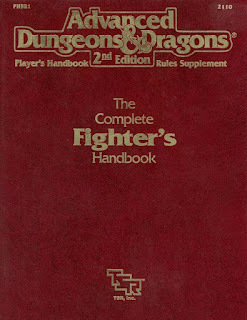Retrospective: The Complete Fighter's Handbook
 AD&D 2nd Edition catches a lot of flak among old schoolers and I completely understand why that is. Nevertheless, as I've stated before, I don't think it's nearly as bad as its somewhat exaggerated reputation would suggest. I played 2e happily for many years and have fond memories of the adventures and campaigns in which I participated. For that matter, I probably wouldn't hesitate to play 2e again if someone I knew were starting up a new campaign using those rules. In short, I think 2nd Edition is just fine, even if it's not my preferred version of Dungeons & Dragons.
AD&D 2nd Edition catches a lot of flak among old schoolers and I completely understand why that is. Nevertheless, as I've stated before, I don't think it's nearly as bad as its somewhat exaggerated reputation would suggest. I played 2e happily for many years and have fond memories of the adventures and campaigns in which I participated. For that matter, I probably wouldn't hesitate to play 2e again if someone I knew were starting up a new campaign using those rules. In short, I think 2nd Edition is just fine, even if it's not my preferred version of Dungeons & Dragons.
That's not to say 2e is not without problems – or, at least, that the larger 2e game line is not without problems and big ones at that. One of the biggest can be seen in its inordinate fondness for bloated (and frequently mechanically dubious) supplements, like 1989's The Complete Fighter's Handbook by Aaron Allston. This was the book that launched a thousand supplements, inaugurating not just the "PHBR" series, which would eventually include fifteen different volumes, but also the "DMGR" (9 volumes) and the "HR" (7 volumes) series as well. These supplements were of varying quality and entirely optional, but, as is so often the case, their mere existence placed a lot of pressure on referees to allow their use in their campaigns, often with disastrous results.At 124 pages in length, The Complete Fighter's Handbook is an eclectic mix of new and optional rules for use by players of the fighter class and by Dungeon Masters wishing to include additional levels of details with regards to armor, weapons, combat, and related topics. In principle, it's not a bad idea for a supplement, akin in some respects to Traveller's Mercenary , both in terms of its content and the way that its publication changed the game forever. Once The Complete Fighter's Handbook was published, it was inevitable that there'd eventually be Complete Handbooks for every class and race in the game, each one adding further complexity and ever greater demands on the referee.
The book begins with a lengthy, eight-page treatment of armor and weapon smithing in the context of 2e's non-weapon proficiency system. On the one hand, that's a genuinely useful and even interesting subject for players and referees who want that level of detail in their campaign. On the other, it's also a lot of new rules material that most players and referees simply won't want. Ultimately, that's the paradox of this book: there's some good stuff in here, but I'm not sure the juice is worth the squeeze. It's also, as I've said, the first step on the supplement treadmill that would come to characterize AD&D 2nd Edition – not to mention undermining the edition's very raison d'être of making AD&D clearer, simpler, and more accessible. Alas, the need to keep selling books trumps all.
Next up are 24 pages devoted to 14 different "kits," a concept first introduced in Time of the Dragon , along with guidelines for modifying the kits or creating one's own. Unlike the kits from Time of Dragon, those presented here are mostly rather "generic" – gladiator, peasant hero, pirate, etc. – rather than being immersed in a specific cultural or social context. This is the same problem that would later befall 3e's prestige classes and probably for the same reason: it's harder to sell game material that is tied to a specific setting than it is to sell material usable by anyone who pays their $15.
Then there's a similarly long section devoted to "roleplaying" that is a mixture of the banal ("warrior personalities"), the basic (campaign structure), and the half-interesting ("one-warrior type campaigns"). In many ways, this section exemplifies the Complete Handbook series as a whole: an overwritten mix of good and bad, with much of it unnecessary. The remaining half of the book is like this, too – lots of rules options relating to weapon proficiencies, combat, and equipment, mixed up with occasional bits of advice regarding their implementation. There's simply so much of it that I shudder at the thought of any referee making use of more than just a tiny percentage, because I imagine the effects of using more than that in a campaign would be confusion at best and catastrophe at worst.
That, ultimately, is my primary criticism of The Complete Fighter's Handbook and the books it inspired: it's too much and to little good end. There are a few good ideas scattered throughout but finding them is like looking for a diamond among a mountain of coal. Worse, as I've said, is the way that this book laid the groundwork for a new philosophy not just of play but of publishing that would hobble AD&D 2nd Edition until its – and TSR's – demise. I genuinely wish that weren't the case, because I think there's the germ of a good idea behind this book, but it's buried under so much dross that I find it hard to render a positive judgment in the end – a pity!
Published on April 02, 2024 21:00
No comments have been added yet.
James Maliszewski's Blog
- James Maliszewski's profile
- 3 followers
James Maliszewski isn't a Goodreads Author
(yet),
but they
do have a blog,
so here are some recent posts imported from
their feed.



